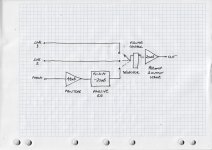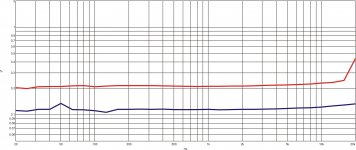EF184 = 6EJ7
Since this tube has high mu as a triode, high gm, and is still pretty cheap, I'm wondering if anyone has tried it as a triode for the input tube of a phono stage? Horror stories? Successes? Noisy?
I was thinking it could be used with the plate grounded and the screen used as the 'plate' (lower input capacitance that way).
As a pentode, the Cag spec is only 0.005pF. I don't know how that translates to triode, but that's 10X less than a pentode like 6AU6A. Perhaps as a triode the Cag is down below 1pF?
Since this tube has high mu as a triode, high gm, and is still pretty cheap, I'm wondering if anyone has tried it as a triode for the input tube of a phono stage? Horror stories? Successes? Noisy?
I was thinking it could be used with the plate grounded and the screen used as the 'plate' (lower input capacitance that way).
As a pentode, the Cag spec is only 0.005pF. I don't know how that translates to triode, but that's 10X less than a pentode like 6AU6A. Perhaps as a triode the Cag is down below 1pF?
I have no experiences with the EF184 but attached a schematic of a phono preamplifier with the EF184 in triode mode from Pete Millett.
The attached Philips datasheet for the EF184 states that Cg1g2 = 2.8 pF. So I think that in normal triode mode Cag will be a bit higher than this 2.8 pF, and as a triode with g2 as the plate (and the real plate grounded) Cag will be 2.8 pF.
The attached Philips datasheet for the EF184 states that Cg1g2 = 2.8 pF. So I think that in normal triode mode Cag will be a bit higher than this 2.8 pF, and as a triode with g2 as the plate (and the real plate grounded) Cag will be 2.8 pF.
Attachments
Try it. What can it hurt?
But the high Gm is especially at high current, suitable for RF amps with coil loading. In resistance-loaded audio we typically run much lower current. Another (or same) reason is that in audio tubes, flicker noise may exceed thermal hiss over most of the audio band. (And the 1/f component is especially troublesome with heavy bass-boost such as RIAA.)
Grid capacitance is surely "small", or "not large", compared to cable capacitance?
Grounding the plate (at LOW current) is cheap convenient shielding, always a good thing here.
But the high Gm is especially at high current, suitable for RF amps with coil loading. In resistance-loaded audio we typically run much lower current. Another (or same) reason is that in audio tubes, flicker noise may exceed thermal hiss over most of the audio band. (And the 1/f component is especially troublesome with heavy bass-boost such as RIAA.)
Grid capacitance is surely "small", or "not large", compared to cable capacitance?
Grounding the plate (at LOW current) is cheap convenient shielding, always a good thing here.
Hi
in attache The Phono Stage.
It is a single son made by me for a friend years ago. And published months ago In audioreview magazine.
There are two stage with gain made woth EF184 Telefunken in a triode mode.
Each gain stage is connected in dc with a cathode follower with a ECC88/6H6/6H30.
Between two stage there is a riaa network at low frequency.
It is full dual mono.
The firsr version was made with tube recrtifier and a C-L-C-L-C filter, around 4.000 uF each channel.
Then I switched to the regulate HT after the first stage with tubec (GZ34, one for each channel.)
The results are fine and about s/n was the highest ratio for a tube phono measure in Audioreview, 82-84 dB.
The gain is variable in three position, 40-43-46 dB
Also the load is variable on 6 position.
All by rele on board with a little pcb connected on pin jack.
Depends on selection of EF184; I found the Telefunkes as the best.
In attach also the FFT at frequency response of both channels.
And the THD vs Freq at 2 Vout
Walter
in attache The Phono Stage.
It is a single son made by me for a friend years ago. And published months ago In audioreview magazine.
There are two stage with gain made woth EF184 Telefunken in a triode mode.
Each gain stage is connected in dc with a cathode follower with a ECC88/6H6/6H30.
Between two stage there is a riaa network at low frequency.
It is full dual mono.
The firsr version was made with tube recrtifier and a C-L-C-L-C filter, around 4.000 uF each channel.
Then I switched to the regulate HT after the first stage with tubec (GZ34, one for each channel.)
The results are fine and about s/n was the highest ratio for a tube phono measure in Audioreview, 82-84 dB.
The gain is variable in three position, 40-43-46 dB
Also the load is variable on 6 position.
All by rele on board with a little pcb connected on pin jack.
Depends on selection of EF184; I found the Telefunkes as the best.
In attach also the FFT at frequency response of both channels.
And the THD vs Freq at 2 Vout
Walter
Attachments
-
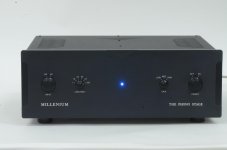 Phono_Stage_Apertura.jpg327.2 KB · Views: 693
Phono_Stage_Apertura.jpg327.2 KB · Views: 693 -
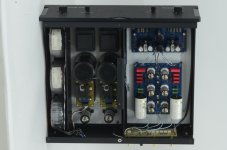 Figura 6_Phono stage_interno_1.jpg521.9 KB · Views: 730
Figura 6_Phono stage_interno_1.jpg521.9 KB · Views: 730 -
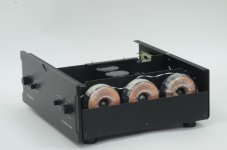 Figura 7_Phono stage_laterale.jpg372.5 KB · Views: 683
Figura 7_Phono stage_laterale.jpg372.5 KB · Views: 683 -
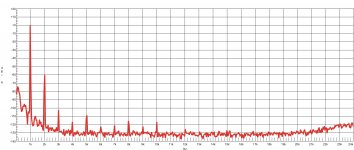 Phono Stage_FFT_2Vout.jpg744.6 KB · Views: 626
Phono Stage_FFT_2Vout.jpg744.6 KB · Views: 626 -
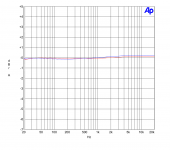 Phono Stage_risp_2Vout_L+R.png52.9 KB · Views: 650
Phono Stage_risp_2Vout_L+R.png52.9 KB · Views: 650 -
 THD_Freq_Low_Mid_High_2Vout.jpg720.1 KB · Views: 321
THD_Freq_Low_Mid_High_2Vout.jpg720.1 KB · Views: 321
Last edited:
EF184 = 6EJ7
As a pentode, the Cag spec is only 0.005pF. I don't know how that translates to triode, but that's 10X less than a pentode like 6AU6A. Perhaps as a triode the Cag is down below 1pF?
But in pentode the Cag is low b/c the screens (g2 and g3) shield the grids from the plate. There is no apparent voltage swing to create the miller either, so the Cag remains low even with high gain.
In triode, you are not using any screens between the grid and the plate (or g3 if that is your 'plate'). So now you have miller capacitance as in any triode.
The Cag without the screens is not listed in datasheet, but when there is no screen between grid and plate it surely will be higher.
That said, tube capacitances are not as bad as might be thought. In SS the capacitances are very nonlinear and contribute to distortions and other 'nasties' (for those who can hear and measure such).
With tubes the capacitances are constant and do not vary with signal so it is not nonlinear and does not cause distortions.
With MM pickups you usually need some input capacitance anyways. Often in the 100pF and more, so if your tube's input cap might be perfectly ok.
So lets say you have C grid-plate in triode mode of 5pF, and gain is 30x, the miller effect makes this into 5pFx30=150pF. Perhaps right where you want it for a MM pickup?,
The EF184/6EJ7 is supposedly very linear in triode mode. I've seen it mentioned as a 'sleeper' with great potential. Some pentodes tend to be microphonic, and this may be the biggest issue if used in the first gain stage.
I have some 6EJ7s and would very much like to hear your results with them.
Hi
in attache The Phono Stage.
It is a single son made by me for a friend years ago. And published months ago In audioreview magazine.
There are two stage with gain made woth EF184 Telefunken in a triode mode.
Each gain stage is connected in dc with a cathode follower with a ECC88/6H6/6H30.
Between two stage there is a riaa network at low frequency.
It is full dual mono.
The firsr version was made with tube recrtifier and a C-L-C-L-C filter, around 4.000 uF each channel.
Then I switched to the regulate HT after the first stage with tubec (GZ34, one for each channel.)
The results are fine and about s/n was the highest ratio for a tube phono measure in Audioreview, 82-84 dB.
The gain is variable in three position, 40-43-46 dB
Also the load is variable on 6 position.
All by rele on board with a little pcb connected on pin jack.
Depends on selection of EF184; I found the Telefunkes as the best.
In attach also the FFT at frequency response of both channels.
Walter
Wow. Looks amazing. I might just have to get out my 6EJ7s and try them.
Since this tube has high mu as a triode, high gm, and is still pretty cheap, I'm wondering if anyone has tried it as a triode for the input tube of a phono stage?
Not as a triode but in Frank Blohbaum's "BestPentode" mode - a screen cascode using a high voltage BJT (the 400V rated MPSA44 in my case).
With 10k on the plate of the 6EJ7 and cathode bias courtesy of an infrared LED (1.2V), I applied 265V as B+ to get 150V Vak, drawing a bit over 11mA through the 6EJ7. Gain was 155 (about 44dB). Output impedance is near as damn equal to the 10k plate resistor, so you have to take that into account in the RIAA calcs.
Advantages are it's quiet (only a little noisier than a triode, if you could even get one with mu=155), lots of gain, and cheap.
The main disadvantage I found was that the power supply must be very quiet because the pentode PSSR is close to nothing at all.
The use of EF184 in triode mode is because I can get a good mu, around 55, with a relatively low Rp.
This, with a CF and a low Z riaa network helps for s/n
In addition the use of a good HT stabilized supply helps to get a very good results.
The use, in a phono, of a pentode, in my opinion, hasn't any reason.
About gain, with the circuit I used I can get around 46 dB that is more than normally we need for MM:
In attach the curves of 184 in triode mode made by Sofia.
With around 250 Vdc of HT to get the 1% of THD I send 280 mV at 1 kHz in input and I have 33 Vrms in output
Walter
This, with a CF and a low Z riaa network helps for s/n
In addition the use of a good HT stabilized supply helps to get a very good results.
The use, in a phono, of a pentode, in my opinion, hasn't any reason.
About gain, with the circuit I used I can get around 46 dB that is more than normally we need for MM:
In attach the curves of 184 in triode mode made by Sofia.
With around 250 Vdc of HT to get the 1% of THD I send 280 mV at 1 kHz in input and I have 33 Vrms in output
Walter
Attachments
Last edited:
In addition,
the E280f, in my opinion, is better but expensive and difficult to find nos/nib
The 184 are more easy with a reasonble prices so the selection will be easy.
Walter
the E280f, in my opinion, is better but expensive and difficult to find nos/nib
The 184 are more easy with a reasonble prices so the selection will be easy.
Walter
The 6SH51P, it's Russian version, is even cheaper. I'm not informed about it's quality and reliability, though.
Best regards!
Best regards!
Thanks for the replies!
The main reason I'm looking at EF184 / 6EJ7 / 651P is that it's still widely available, it's relatively cheap, and I'm hoping its input capacitance (Cin) is much lower than other high mu triodes. As Waltube pointed out, 6EJ7-triode gets you that high mu with high gm, therefore with relatively low rp.
I've been fixated on triode Miller capacitance lately because after building a 12AX7-based phono stage I've found that the high Cin (200pF?) messes with the sound of the MM cartridges I'm using. I have an old Pickering XV15 and a late-era Shure SC35C (with aftermarket elliptical Jico stylus), both of which sound nice into the 12AX7. However my Audio Technica ATVM95-E sounds screechy into the 12AX7, even though I like its sound the best of the bunch through my op-amp based phono stages (Hagerman Bugle and Schiit Mani).
I figure the Cin of the 12AX7 is about 200pF, tonearm wiring C is 30pF, tonearm cable C is around 150pF. Add that up and you get almost 400pF, which is near the recommended load C for the Pickering XV15, but far too high for the ATVM95 (<200pF recommended load).
According to the Philips datasheet, E180F in triode has Cga of 0.03pF in pentode, with Cga of between 2.5 and 3.5pF when wired triode. With realizable mu of around 50 and adding 1pF for strays, that means the Cin could be as high as 200pF, which is about the same as for a 12AX7.
Merlinb measured the 6J52P Cin at over 250pF in triode, which is even higher than for a 12AX7.
The 6EJ7 data sheet says Cga is 0.005pF. That's super low compared to 0.03pF for E180F (pentode). Does that mean the Cga for a triode-wired 6EJ7 will be much lower than that of an E180F-triode?
I'm also intrigued by the grounded-plate triode config (screen as plate). Reduces Cga by putting a shield around the 'plate'.
Waltube, is the basic topology of that EF184-triode phono stage the same as the 12AX7-based phono stage you've shown elsewhere? In other words...
EF184-triode > ECC88 cathode follower > RIAA EQ > EF184-triode > ECC88 CF?
If two EF184-triode in cascade with passive RIAA EQ in between yields a final gain of about +45dB, AND that comes with Cin of 100pF or less, then I'M SOLD!
--
The main reason I'm looking at EF184 / 6EJ7 / 651P is that it's still widely available, it's relatively cheap, and I'm hoping its input capacitance (Cin) is much lower than other high mu triodes. As Waltube pointed out, 6EJ7-triode gets you that high mu with high gm, therefore with relatively low rp.
I've been fixated on triode Miller capacitance lately because after building a 12AX7-based phono stage I've found that the high Cin (200pF?) messes with the sound of the MM cartridges I'm using. I have an old Pickering XV15 and a late-era Shure SC35C (with aftermarket elliptical Jico stylus), both of which sound nice into the 12AX7. However my Audio Technica ATVM95-E sounds screechy into the 12AX7, even though I like its sound the best of the bunch through my op-amp based phono stages (Hagerman Bugle and Schiit Mani).
I figure the Cin of the 12AX7 is about 200pF, tonearm wiring C is 30pF, tonearm cable C is around 150pF. Add that up and you get almost 400pF, which is near the recommended load C for the Pickering XV15, but far too high for the ATVM95 (<200pF recommended load).
According to the Philips datasheet, E180F in triode has Cga of 0.03pF in pentode, with Cga of between 2.5 and 3.5pF when wired triode. With realizable mu of around 50 and adding 1pF for strays, that means the Cin could be as high as 200pF, which is about the same as for a 12AX7.
Merlinb measured the 6J52P Cin at over 250pF in triode, which is even higher than for a 12AX7.
The 6EJ7 data sheet says Cga is 0.005pF. That's super low compared to 0.03pF for E180F (pentode). Does that mean the Cga for a triode-wired 6EJ7 will be much lower than that of an E180F-triode?
I'm also intrigued by the grounded-plate triode config (screen as plate). Reduces Cga by putting a shield around the 'plate'.
Waltube, is the basic topology of that EF184-triode phono stage the same as the 12AX7-based phono stage you've shown elsewhere? In other words...
EF184-triode > ECC88 cathode follower > RIAA EQ > EF184-triode > ECC88 CF?
If two EF184-triode in cascade with passive RIAA EQ in between yields a final gain of about +45dB, AND that comes with Cin of 100pF or less, then I'M SOLD!
--
I don' know of which construction the E180F is, but I can tell for sure that the EF184 is a frame grid tube with relatively small plate structures. Both yields to that small Cga. And yes, it's triode capacitance also is smaller than the E180F's.The 6EJ7 data sheet says Cga is 0.005pF. That's super low compared to 0.03pF for E180F (pentode). Does that mean the Cga for a triode-wired 6EJ7 will be much lower than that of an E180F-triode?
Best regards!
to Rangon,
Yes, as you listed.
I think is the best solution in terms of gain, s/n and precision.
Also the headroom is very high.
I repeat, as I know, The Phono Stage is the quietest tube phono ever measured in the magazine lab (hundred of them).
But take a care on HT supply, it has a great impact.
Walter
Walter
Yes, as you listed.
I think is the best solution in terms of gain, s/n and precision.
Also the headroom is very high.
I repeat, as I know, The Phono Stage is the quietest tube phono ever measured in the magazine lab (hundred of them).
But take a care on HT supply, it has a great impact.
Walter
Walter
Ah, I see that now. Thanks.
When you strap the EF184 to triode, the g2 and and anode will be shorted together.
Does that mean the capacitance from g2 to g1 will then define the capacitance Cga of the triode?
If so, then if the EF184-triode Cga is 2.8pF (let's say 3.5pF including strays) and the triode's achievable mu is 40, Cinput ends up not looking so good at 140pF. Still better than a 12AX7, but not as low as a 6DJ8.
The Philips E180F data sheet doesn't show Cg1g2.
The Philips E810F data sheet quotes "Grid no.1 to all other elements except anode" is a whopping 14.5pF.
The Philips D3a data sheet (https://frank.pocnet.net/sheets/009/d/D3a.pdf) shows "Grid No.1 to cathode and grid No.2" as 9.5pF.
I guess the solution is to go with the frame grid RF triodes like 6GK5, with Cga = 0.52pF and mu = about 75. Or the old standby ECC88/6DJ8.
Oh well. I hope that's not the final word on this.
--
When you strap the EF184 to triode, the g2 and and anode will be shorted together.
Does that mean the capacitance from g2 to g1 will then define the capacitance Cga of the triode?
If so, then if the EF184-triode Cga is 2.8pF (let's say 3.5pF including strays) and the triode's achievable mu is 40, Cinput ends up not looking so good at 140pF. Still better than a 12AX7, but not as low as a 6DJ8.
The Philips E180F data sheet doesn't show Cg1g2.
The Philips E810F data sheet quotes "Grid no.1 to all other elements except anode" is a whopping 14.5pF.
The Philips D3a data sheet (https://frank.pocnet.net/sheets/009/d/D3a.pdf) shows "Grid No.1 to cathode and grid No.2" as 9.5pF.
I guess the solution is to go with the frame grid RF triodes like 6GK5, with Cga = 0.52pF and mu = about 75. Or the old standby ECC88/6DJ8.
Oh well. I hope that's not the final word on this.
--
How about cascoding? The gain is then -1 (assuming equal transconductances of the input and cascode valve), so the capacitance only doubles. Or use a pentode as a pentode and take the partition noise for granted. With just a triode, maybe you could arrange the RIAA network such that the gain is far less than 40 for frequencies above 10 kHz, where the capacitance matters most.
Last edited:
Pentode phono has its place too
There are lot's of good pentodes out there like the the 6EJ7/EF184 and they have their place when high gain is required. Frank's circuit also offers the bonus of low noise and distortion (Frank's BestPentode article in Linear Audio Vol 0 is well worth the 3 Euro purchase price, and another 3 Euro gets you Merlin Blencowe's later article on triodes, pentodes and BestPentodes in Vol 10)
Lots of low noise gain in the first stage is often a good thing for phono and microphone preamps - it can help reduce the total number of gain stages in the circuit. To illustrate I have attached a block diagram of a preamp including a phono stage. The line levels go staright through the switch to the volume control and then to the final gain/output stage (the mu stages are pretty good for the output task). The phono stage gets a big hit of gain from a pentode followed by passive RIAA eq before the switch and volume control. With attention to impedances and a good quiet power supply, we get a full function preamp with RIAA gain so that a moving magnet cart delivering 5mV peak will deliver 1VRMS out.
The use, in a phono, of a pentode, in my opinion, hasn't any reason.
There are lot's of good pentodes out there like the the 6EJ7/EF184 and they have their place when high gain is required. Frank's circuit also offers the bonus of low noise and distortion (Frank's BestPentode article in Linear Audio Vol 0 is well worth the 3 Euro purchase price, and another 3 Euro gets you Merlin Blencowe's later article on triodes, pentodes and BestPentodes in Vol 10)
Lots of low noise gain in the first stage is often a good thing for phono and microphone preamps - it can help reduce the total number of gain stages in the circuit. To illustrate I have attached a block diagram of a preamp including a phono stage. The line levels go staright through the switch to the volume control and then to the final gain/output stage (the mu stages are pretty good for the output task). The phono stage gets a big hit of gain from a pentode followed by passive RIAA eq before the switch and volume control. With attention to impedances and a good quiet power supply, we get a full function preamp with RIAA gain so that a moving magnet cart delivering 5mV peak will deliver 1VRMS out.
Attachments
ro rangon
which is the target gain of riaa stage?
With the 184 in triode, two stage ( as described) I get 46 dB, 200 times, that is fine for every MM.
to bondini
I always test on lab the results. So if one certain configuration give me the best resuslts as THD and s/n ( mainly for a phono) I will adopetd it maybe with some adjustement.
Then, until I don'see the same results ( or similar) on lab with different config I assume that are only words.
With a pentode config in a phono you can't get that type of results.
- 82/84 dB of s/n ( weighted) it is very high, this means that the stage is completely "death"
And these results, in my opinion, is possible to get only with a low Rp and riaa network with low Z
Plus a perfect HT stabilization + filtering
Walter
In attach the THD vs Freq at 5 and 10 Vout with a gain of 42 dB
which is the target gain of riaa stage?
With the 184 in triode, two stage ( as described) I get 46 dB, 200 times, that is fine for every MM.
to bondini
I always test on lab the results. So if one certain configuration give me the best resuslts as THD and s/n ( mainly for a phono) I will adopetd it maybe with some adjustement.
Then, until I don'see the same results ( or similar) on lab with different config I assume that are only words.
With a pentode config in a phono you can't get that type of results.
- 82/84 dB of s/n ( weighted) it is very high, this means that the stage is completely "death"
And these results, in my opinion, is possible to get only with a low Rp and riaa network with low Z
Plus a perfect HT stabilization + filtering
Walter
In attach the THD vs Freq at 5 and 10 Vout with a gain of 42 dB
Attachments
If so, then if the EF184-triode Cga is 2.8pF (let's say 3.5pF including strays) and the triode's achievable mu is 40, Cinput ends up not looking so good at 140pF. Still better than a 12AX7, but not as low as a 6DJ8.
To calculate Cmiller you need gain between anode and g1 , not mu. These are not the same, except with mu- follower circuit.
Humble ECC81 can give you Cmiller <100pf with little care, if thats your goal.
Also much lower output resistance than ECC83 and good noise and microphony performance.
- Home
- Amplifiers
- Tubes / Valves
- EF184 in triode for phono stage input?

